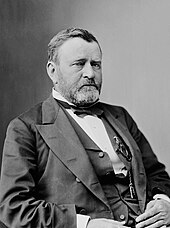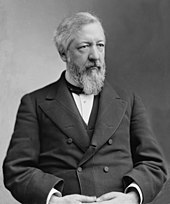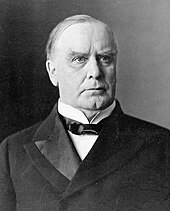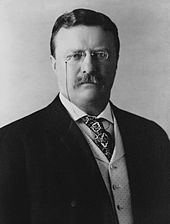
A | B | C | D | E | F | G | H | CH | I | J | K | L | M | N | O | P | Q | R | S | T | U | V | W | X | Y | Z | 0 | 1 | 2 | 3 | 4 | 5 | 6 | 7 | 8 | 9
Republican Party | |
|---|---|
 | |
| Abbreviation | GOP |
| Chairperson | Michael Whatley |
| Governing body | Republican National Committee |
| Speaker of the House | Mike Johnson |
| Senate Minority Leader | Mitch McConnell |
| House Majority Leader | Steve Scalise |
| Founders | Alvan E. Bovay[1] Henry J. Raymond[2] |
| Founded | March 20, 1854 Ripon, Wisconsin, U.S. |
| Merger of | Free Soil Party[3] Anti-Nebraska movement[4] Whig Party (northern faction)[5][6][7][8] |
| Headquarters | 310 First Street SE, Washington, D.C., U.S. |
| Student wing | College Republicans |
| Youth wing | |
| Women's wing | National Federation of Republican Women |
| Overseas wing | Republicans Overseas |
| Ideology | Majority: Factions: |
| European affiliation | European Conservatives and Reformists Party (global partner)[15] |
| International affiliation | International Democracy Union[16] |
| Colors | Red |
| Senate | 49 / 100 |
| House of Representatives | 217 / 435 |
| State Governors | 27 / 50 |
| State upper chambers | 1,110 / 1,973 |
| State lower chambers | 2,948 / 5,413 |
| Territorial Governors | 0 / 5 |
| Territorial upper chambers | 12 / 97 |
| Territorial lower chambers | 9 / 91 |
| Election symbol | |
 | |
| Website | |
| gop | |
The Republican Party, also known as the GOP (Grand Old Party), is one of the two major contemporary political parties in the United States. It emerged as the main political rival of the Democratic Party in the mid-1850s.
The party was founded in 1854 by anti-slavery activists who opposed the Kansas–Nebraska Act, an act which allowed for the potential expansion of chattel slavery into the western territories of Kansas and Nebraska.[17] It supported classical liberalism and economic reform[18] while opposing the expansion of slavery into the free territories. The party initially had a very limited presence in the South, but was successful in the North. By 1858, it had enlisted most former Whigs and former Free Soilers to form majorities in nearly every northern state. White Southerners became alarmed at the threat to slavery. With the 1860 election of Abraham Lincoln, the first Republican president, the deep Southern states seceded from the United States.
Under the leadership of Lincoln and a Republican Congress, the Republican Party led the fight to defeat the Confederate States in the American Civil War, preserving the Union and abolishing slavery. Afterward, the party largely dominated the national political scene until the Great Depression in the 1930s, when it lost its congressional majorities and the Democrats' New Deal programs proved popular. Dwight D. Eisenhower's election was a rare break in between Democratic presidents and he presided over a period of increased economic prosperity after World War II. His former vice president Richard Nixon carried 49 states in 1972 with what he touted as his silent majority. The 1980 election of Ronald Reagan realigned national politics, bringing together advocates of free-market economics, social conservatives, and Cold War foreign policy hawks under the Republican banner.[19] Since 2008, Republicans have faced increased factionalism within the party's ranks.[20][11] As of 2024, Trumpists are the dominant faction within the GOP.[a]
In the 21st century, the party receives its strongest support from rural voters, evangelical Christians, men, senior citizens, veterans, white voters, and voters who did not graduate from college.[28] On social issues, it advocates for restricting the legality of abortion, prohibiting recreational drug use, loosening gun restrictions, overturning the legality of same-sex marriage and opposing the transgender rights movement. On economic issues, the party supports tax cuts and deregulation while opposing labor unions and universal health care. In foreign policy, the party includes both those who promote tough stances against China and Russia and those who promote non-interventionism and isolationism.
History
19th century


In 1854, the Republican Party was founded in the Northern United States by forces opposed to the expansion of slavery, ex-Whigs, and ex-Free Soilers. The Republican Party quickly became the principal opposition to the dominant Democratic Party and the briefly popular Know Nothing Party. The party grew out of opposition to the Kansas–Nebraska Act, which repealed the Missouri Compromise and opened the Kansas and Nebraska Territories to slavery and future admission as slave states.[29][30] They denounced the expansion of slavery as a great evil, but did not call for ending it in the Southern states. While opposition to the expansion of slavery was the most consequential founding principle of the party, like the Whig Party it replaced, Republicans also called for economic and social modernization.[31]
At the first public meeting of the anti-Nebraska movement on March 20, 1854, at the Little White Schoolhouse in Ripon, Wisconsin, the name "Republican" was proposed as the name of the party.[32] The name was partly chosen to pay homage to Thomas Jefferson's Democratic-Republican Party.[33] The first official party convention was held on July 6, 1854, in Jackson, Michigan.[34]
The party emerged from the great political realignment of the mid-1850s, united in pro-capitalist stances with members often valuing Radicalism.[35] Historian William Gienapp argues that the great realignment of the 1850s began before the Whigs' collapse, and was caused not by politicians but by voters at the local level. The central forces were ethno-cultural, involving tensions between pietistic Protestants versus liturgical Catholics, Lutherans and Episcopalians regarding Catholicism, prohibition and nativism. The Know Nothing Party embodied the social forces at work, but its weak leadership was unable to solidify its organization, and the Republicans picked it apart. Nativism was so powerful that the Republicans could not avoid it, but they did minimize it and turn voter wrath against the threat that slave owners would buy up the good farm lands wherever slavery was allowed. The realignment was powerful because it forced voters to switch parties, as typified by the rise and fall of the Know Nothings, the rise of the Republican Party and the splits in the Democratic Party.[36][37]
At the Republican Party's first National Convention in 1856, held at Musical Fund Hall in Philadelphia, the party adopted a national platform emphasizing opposition to the expansion of slavery into the free territories.[38] While Republican nominee John C. Frémont lost that year's presidential election to Democrat James Buchanan, Buchanan managed to win only four of the fourteen northern states and won his home state of Pennsylvania only narrowly.[39][40] Republicans fared better in congressional and local elections, but Know Nothing candidates took a significant number of seats, creating an awkward three-party arrangement. Despite the loss of the presidency and the lack of a majority in the U.S. Congress, Republicans were able to orchestrate a Republican speaker of the House of Representatives, which went to Nathaniel P. Banks. Historian James M. McPherson writes regarding Banks' speakership that "if any one moment marked the birth of the Republican party, this was it."[41]

The Republicans were eager for the 1860 elections.[42] Former Illinois U.S. representative Abraham Lincoln spent several years building support within the party, campaigning heavily for Frémont in 1856 and making a bid for the Senate in 1858, losing to Democrat Stephen A. Douglas but gaining national attention from the Lincoln–Douglas debates it produced.[40][43] At the 1860 Republican National Convention, Lincoln consolidated support among opponents of New York U.S. senator William H. Seward, a fierce abolitionist who some Republicans feared would be too radical for crucial states such as Pennsylvania and Indiana, as well as those who disapproved of his support for Irish immigrants.[42] Lincoln won on the third ballot and was ultimately elected president in the general election in a rematch against Douglas. Lincoln had not been on the ballot in a single Southern state, and even if the vote for Democrats had not been split between Douglas, John C. Breckinridge and John Bell, the Republicans would have still won but without the popular vote.[42] This election result helped kickstart the American Civil War, which lasted from 1861 until 1865.[44]
The 1864 presidential election united War Democrats with the GOP in support of Lincoln and Tennessee Democratic senator Andrew Johnson, who ran for president and vice president on the National Union Party ticket;[39] Lincoln was re-elected.[45] By June 1865, slavery was dead in the ex-Confederate States but remained legal in some border states. Under Republican congressional leadership, the Thirteenth Amendment to the U.S. Constitution—which banned slavery, except as punishment for a crime—passed the Senate on April 8, 1864, the House of Representatives on January 31, 1865, and was ratified by the required 27 of the then 36 states on December 6, 1865.[46]
Reconstruction, the gold standard, and the Gilded Age

Radical Republicans during Lincoln's presidency felt he was too moderate in his efforts to eradicate slavery and opposed his ten percent plan. Radical Republicans passed the Wade–Davis Bill in 1864, which sought to enforce the taking of the Ironclad Oath for all former Confederates. Lincoln vetoed the bill, believing it would jeopardize the peaceful reintegration of the ex-Confederate states.[47]
Following the assassination of Lincoln, Johnson ascended to the presidency and was deplored by Radical Republicans. Johnson was vitriolic in his criticisms of the Radical Republicans during a national tour ahead of the 1866 elections.[48] Anti-Johnson Republicans won a two-thirds majority in both chambers of Congress following the elections, which helped lead the way toward his impeachment and near ouster from office in 1868,[48] the same year former Union Army general Ulysses S. Grant was elected as the next Republican president.
Grant was a Radical Republican, which created some division within the party. Massachusetts senator Charles Sumner and Illinois senator Lyman Trumbull opposed most of his Reconstructionist policies.[49] Others took issue with the large-scale corruption present in the Grant administration, with the emerging Stalwart faction defending Grant and the spoils system, and the Half-Breeds advocating reform of the civil service.[50] Republicans who opposed Grant branched off to form the Liberal Republican Party, nominating Horace Greeley in the 1872 presidential election. The Democratic Party attempted to capitalize on this divide in the GOP by co-nominating Greeley under their party banner. Greeley's positions proved inconsistent with the Liberal Republican Party that nominated him, with Greeley supporting high tariffs despite the party's opposition.[51] Grant was easily re-elected.[52][53]
The 1876 presidential election saw a contentious conclusion as both parties claimed victory despite three southern states still not officially declaring a winner at the end of election day. Voter suppression had occurred in the South to depress the black and white Republican vote, which gave Republican-controlled returning officers enough of a reason to declare that fraud, intimidation and violence had soiled the states' results. They proceeded to throw out enough Democratic votes for Republican Rutherford B. Hayes to be declared the winner.[54] Still, Democrats refused to accept the results and the Electoral Commission made up of members of Congress was established to decide who would be awarded the states' electors. After the Commission voted along party lines in Hayes' favor, Democrats threatened to delay the counting of electoral votes indefinitely so no president would be inaugurated on March 4. This resulted in the Compromise of 1877 and Hayes finally became president.[55]

Hayes doubled down on the gold standard, which had been signed into law by Grant with the Coinage Act of 1873, as a solution to the depressed American economy in the aftermath of that year's panic. He also believed greenbacks posed a threat; greenbacks being money printed during the Civil War that was not backed by specie, which Hayes objected to as a proponent of hard money. Hayes sought to restock the country's gold supply, which by January 1879 succeeded as gold was more frequently exchanged for greenbacks compared to greenbacks being exchanged for gold.[56] Ahead of the 1880 presidential election, Republican James G. Blaine ran for the party nomination, supporting both Hayes' gold standard push and his civil service reforms. After both Blaine and opponent John Sherman failed to win the Republican nomination, each of them backed James A. Garfield for president. Garfield agreed with Hayes' move in favor of the gold standard, but opposed his civil reform efforts.[57][58]
Garfield won the 1880 presidential election, but was assassinated early in his term. His death helped create support for the Pendleton Civil Service Reform Act, which was passed in 1883;[59] the bill was signed into law by Republican president Chester A. Arthur, who succeeded Garfield.
In 1884, Blaine once again ran for president. He won the Republican nomination, but lost the general election to Democrat Grover Cleveland. Cleveland was the first Democrat to be elected president since James Buchanan. Dissident Republicans, known as Mugwumps, had defected from Blaine due to the corruption which had plagued his political career.[60][61] Cleveland stuck to the gold standard policy,[62] but he came into conflict with Republicans regarding budding American imperialism.[63]

Republican Benjamin Harrison defeated Cleveland in the 1888 election. During his presidency, Harrison signed the Dependent and Disability Pension Act, which established pensions for all veterans of the Union who had served for more than 90 days and were unable to perform manual labor.[64] Following his loss to Cleveland in the 1892 presidential election, Harrison unsuccessfully attempted to pass a treaty annexing Hawaii before Cleveland could be inaugurated. Most Republicans supported the proposed annexation,[65] but Cleveland opposed it.[66]
In the 1896 presidential election, Republican William McKinley's platform supported the gold standard and high tariffs, having been the creator and namesake for the McKinley Tariff of 1890. Though having been divided on the issue prior to that year's National Convention, McKinley decided to heavily favor the gold standard over free silver in his campaign messaging, but promised to continue bimetallism to ward off continued skepticism over the gold standard, which had lingered since the Panic of 1893.[67][68] Democrat William Jennings Bryan proved to be a devoted adherent to the free silver movement, which cost Bryan the support of Democratic institutions such as Tammany Hall, the New York World and a large majority of the Democratic Party's upper and middle-class support.[69] McKinley defeated Bryan[70] and returned the presidency to Republican control until the 1912 presidential election.[71]
First half of the 20th century
Progressives vs. Standpatters

The 1896 realignment cemented the Republicans as the party of big businesses while president Theodore Roosevelt added more small business support by his embrace of trust busting. He handpicked his successor William Howard Taft in the 1908 election, but they became enemies as the party split down the middle. Taft defeated Roosevelt for the 1912 nomination so Roosevelt stormed out of the convention and started a new party. Roosevelt ran on the ticket of his new Progressive Party. He called for social reforms, many of which were later championed by New Deal Democrats in the 1930s. He lost and when most of his supporters returned to the GOP, they found they did not agree with the new conservative economic thinking, leading to an ideological shift to the right in the Republican Party.[72]
The Republicans returned to the presidency in the 1920s, winning on platforms of normalcy, business-oriented efficiency, and high tariffs.[73] The national party platform avoided mention of prohibition, instead issuing a vague commitment to law and order.[74] The Teapot Dome scandal threatened to hurt the party under Warren G. Harding. He died in 1923 and Calvin Coolidge easily defeated the splintered opposition in 1924.[75] The pro-business policies of the decade produced an unprecedented prosperity until the Wall Street Crash of 1929 heralded the Great Depression.[76]
Roosevelt and the New Deal era
Zdroj:https://en.wikipedia.org?pojem=Republican_Party_(US)Text je dostupný za podmienok Creative Commons Attribution/Share-Alike License 3.0 Unported; prípadne za ďalších podmienok. Podrobnejšie informácie nájdete na stránke Podmienky použitia.
Antropológia
Aplikované vedy
Bibliometria
Dejiny vedy
Encyklopédie
Filozofia vedy
Forenzné vedy
Humanitné vedy
Knižničná veda
Kryogenika
Kryptológia
Kulturológia
Literárna veda
Medzidisciplinárne oblasti
Metódy kvantitatívnej analýzy
Metavedy
Metodika
Text je dostupný za podmienok Creative
Commons Attribution/Share-Alike License 3.0 Unported; prípadne za ďalších
podmienok.
Podrobnejšie informácie nájdete na stránke Podmienky
použitia.
www.astronomia.sk | www.biologia.sk | www.botanika.sk | www.dejiny.sk | www.economy.sk | www.elektrotechnika.sk | www.estetika.sk | www.farmakologia.sk | www.filozofia.sk | Fyzika | www.futurologia.sk | www.genetika.sk | www.chemia.sk | www.lingvistika.sk | www.politologia.sk | www.psychologia.sk | www.sexuologia.sk | www.sociologia.sk | www.veda.sk I www.zoologia.sk
